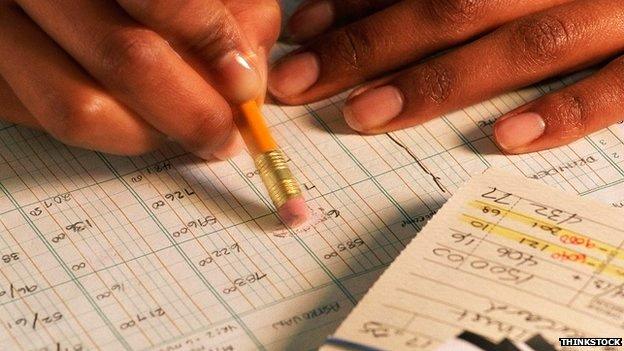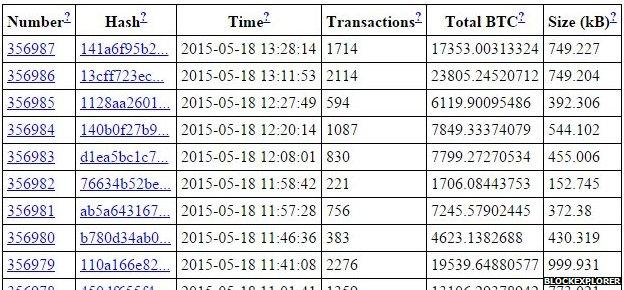Bitcoin's baby: Blockchain's 'tamper-proof' revolution
- Published

Bitcoin is supported by a long list of past transactions that cannot be amended after being recorded
For Bitcoin, 2014 was not a good year. The virtual currency's value slumped as scandal after scandal struck, resulting in many people losing significant amounts of money.
Over recent months the "cryptocurrency" has stabilised, however it is still worth less than a quarter of its peak value against the dollar.
But while Bitcoin's long-term prospects may remain in doubt, some are suggesting that its underlying technology - the Blockchain - has a bright future.

What's their business model?
Blockchain businesses take the technology that underpins Bitcoin - the Blockchain - and use it for things the virtual currency's unidentified creator, "Satoshi Nakamoto", never envisaged when he first published his system for a "truly peer-to-peer electronic cash system".
In Bitcoin, the Blockchain is used to store financial transactions.
The emerging Blockchain companies believe it can be used for much more.
The new projects have been dubbed "Bitcoin 2.0", external - but some Blockchain evangelists are wary of the term because of negative associations with Bitcoin.

OK. So, what is a Blockchain?
In Bitcoin the Blockchain is a ledger.
Imagine walking into the head office of a bank some 80 years ago. Arranged along shelves are a number of hefty, leather-bound books.
You take one down, blow the dust from the cover and open it up. This is the ledger, and each page contains a number of lines, and on each line is listed a transaction: a credit here, a debit there.
The Blockchain is simply a representation of this ledger in the form of an ever-expanding computer file. You can think of a block in the Blockchain representing a page in the ledger.

A Blockchain can be viewed as the modern equivalent of a ledger, but without the need for an accountant
Other characteristics of the Blockchain are:
The Blockchain is split up and distributed over thousands of computers all over the world
These computers compete to be the one to add the next block to the Blockchain
Clever cryptography ensures each block is digitally signed in such a way that changing or altering an entry invalidates every other entry preceding it going right the way back to Block 1. This is what makes each entry in the Blockchain immutable
The uncoordinated nature of the network is what keeps it honest.
To corrupt the system - in other words to hack it - you would have to commandeer more than 50% of the computers on the system. More on this later.

This file must get pretty big?
It does.
"Blockchain bloat" is a problem the Bitcoin community is already trying to address.
At the time of writing, the current size of the Blockchain is a touch under 36GB.
For comparisons sake, that's more storage than many smartphones provide, and enough to fill more than 50 standard CD-Roms.

Other than payments, what else can the Blockchain be used for?
Just about any kind of data you can think of that is transactional in nature and requires immutability - ie information that absolutely cannot be changed after it has been created.
A good example is land titles.
Texas-based Factom is working with a Central American client to try to get their system for registering land titles into a Blockchain.
According to Factom president Peter Kirby, this country had "built a database of all their land title records and some bureaucrats got hold of that and they started giving themselves beachfront property".

It is alleged that officials have misused current land record systems to reward themselves with properties
He added: "With Blockchain technology, you could create a truly tamper-proof record system. Those land title records can go into the Blockchain in a way that I know if anybody tries to change it."
Other candidates for insertion into the Blockchain include contracts, royalty payments, certificates for authenticating art and even government budgets.

Can I look at a Blockchain?
Yes you can.
You can download the Bitcoin Blockchain at any time, external and view transactions in near real-time.

The Bitcoin Blockchain can be inspected by anyone
Alternatively visit www.blockexplorer.com, external and use its simplified interface. Just type in a random block number to view the transactions contained within that block.

That's pretty transparent
Sure is.
And for many this is the most crucial point of all: the Blockchain lacks a central, controlling authority.
With banks, it's the bank that acts as the sole arbiter of the validity of the ledger.
With land, it's the officials controlling the registry.
Both are examples of what techies are fond of calling a single point of failure.
Anti-corruption group Transparency International says there is great potential in a Blockchain's ability to bypass the need for such traditional "gatekeepers".
"Corruption appears when you have a monopoly, somebody with discretionality to decide and when you have opacity," Alejandro Sales, the body's regional director for the Americas tells the BBC.

So, how would I get my government to put its data through a Blockchain?
Not so fast.
The Blockchain's distributed nature and the ability for anyone in the world with a powerful enough computer to participate is both its strength and weakness.
According to the theory, so long as nodes - programs that validate transactions and blocks - don't cooperate to break the system, all goes to plan.

The Bitcoin Blockchain is trustworthy as no single party controls the computing system supporting it
But when it comes to putting all this into practice, one Harvard internet law professor thinks he has spotted a flaw.
"Why would we assume that now and forever no one entity could command more than half of the computing power of the people mining a Blockchain?" asks Prof Jonathan Zittrain.
"I haven't really heard a satisfying answer to that."